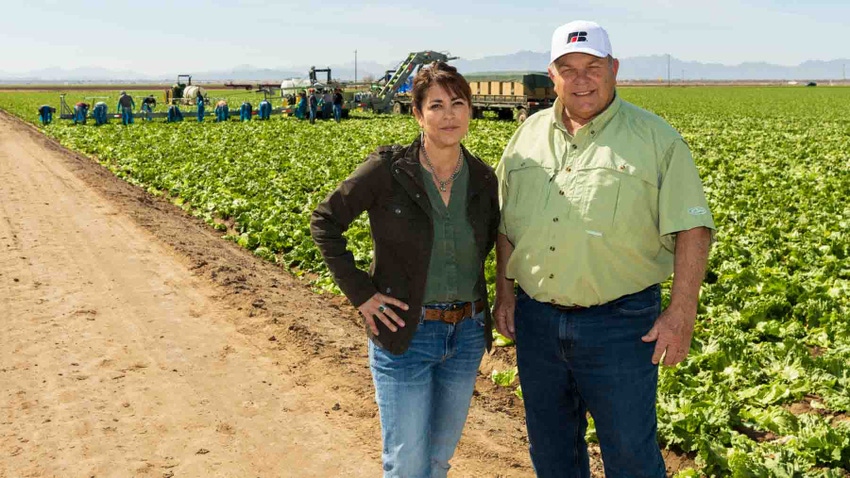
It’s not every day that farmers and agricultural leaders in the West can showcase their region to those who help guide national farm policy. When it does, local leaders do their best to make it a success.
State Farm Bureau presidents who sit on the American Farm Bureau board made the trek to southwest Arizona in mid-March to hear and see first-hand the challenges farmers there have with irrigation, labor and other common issues. For some it was an eye-opening experience to witness the harvest of winter vegetables from a region that supplies most of the nation’s leafy greens from Thanksgiving to Easter.
“It’s amazing that 90% of the greens that Americans eat in certain parts of the year come from this area of the country,” said American Farm Bureau President Zippy Duvall during a stop on the tour.
Duvall led a delegation of Farm Bureau leaders to Arizona as part of a traveling board meeting to different parts of the U.S. These meetings were something Farm Bureau leaders did years ago, but for a variety of reasons stopped, he said. About two years ago discussions at the board level resurrected the idea, so last fall the board traveled to Pennsylvania to see farms in that region.
The board then opted for a spring meeting that Arizona Farm Bureau President Stefanie Smallhouse began touting to local farmers last fall.
Smallhouse farms cattle, forage crops and Saguaro cactus in a nursery setting with her family near Tucson. She was elected state Farm Bureau president six years ago.
“This is significant to have the entire American Farm Bureau board out here in Arizona to give heightened attention to what’s happening on the Colorado River and to inform the rest of the country, particularly the agricultural world, just how special this part of the country is in terms of production,” Smallhouse said.
Smallhouse highlighted the cotton seed production from Arizona that benefits other regions of the U.S. cotton belt.
The two-and-a-half day tour of southwest Arizona for Farm Bureau leaders included stops on several Yuma County farms to see romaine, iceberg, and spinach harvest. It also included a stop at the Dole plant in Yuma to see field-packed lettuce cooled and moved through the processing lines there. Leaders also heard from U.S. Customs and Border Protection officials at the International Border while Mexican residents crossed the border early one morning to board buses and travel to farm fields where they harvested lettuce and other leafy greens crops.
“Very few Americans understand how many men and women from Mexico come across the border and spend their day working in America, and then go back home to their families at night,” said Duvall, a Georgia poultry farmer. “Probably not very many people understand that, and the value that these people bring to our society.”
Duvall was also impressed with the forethought of previous generations of farmers to build water infrastructure to irrigate desert crops.
“If you think about this being a desert, it’s also pretty amazing what it will grow if you have water and it’s available to them,” he said.
Duvall continued: “Every American needs to understand that what we do each and every day provides our country not only with a secure food system, but it’s also a national security issue; without farmers, our country would not be secure if we had to depend on someone else to grow our food.”
Local viewpoint
John Boelts farms lettuce, broccoli, and other vegetable crops in the Yuma area each winter. He also serves as first vice president on the Arizona Farm Bureau board. Together with Smallhouse, they serve as delegates to the American Farm Bureau Federation.
Boelts hosted part of the tour on one of his farms near Wellton, Ariz. During the stop Farm Bureau leaders got to witness field packing of iceberg lettuce and hear of the various labor and general farming challenges growers of leafy greens face with marketing, water, and labor.
The tour, which also included a visit to the University of Arizona’s Research and Extension farm at Yuma, helped paint a picture for national Farm Bureau leaders of the rich fabric that is American agriculture.
“They got to see and hear about how we use water and how important our federal water projects are,” Boelts said.
The national farm leaders also learned of the symbiotic relationship between Arizona, California, and Mexico in this region of North America, where agricultural production relies on a sustainable supply of irrigation water and public policy that allows foreign workers to work in the United States.
“They were at the border before 5 a.m. to see the farmworkers come across the border and watch hundreds of buses move people to fields in the region,” Boelts said.
About the Author(s)
You May Also Like






